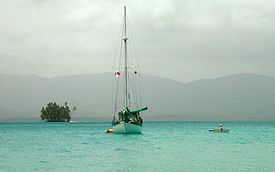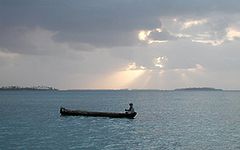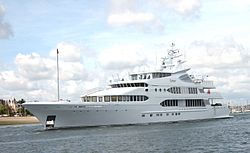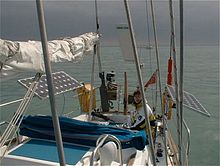- Cruising (maritime)
-
 A cruising sailboat anchored in the San Blas Islands, in Panama. The islands are a destination enjoyed by many cruisers.
A cruising sailboat anchored in the San Blas Islands, in Panama. The islands are a destination enjoyed by many cruisers. This article is about yacht cruising. For cruising on cruise liners see the article Cruise ship.
This article is about yacht cruising. For cruising on cruise liners see the article Cruise ship.Cruising by boat is a lifestyle that involves living for extended time on a boat while traveling from place to place for pleasure. Cruising generally refers to trips of a few days or more, and can extend to round-the-world voyages.
Contents
History
"The sea, the great unifier, is man's only hope. Now, as never before,
the old phrase has a literal meaning: We are all in the same boat." Cruisers can see traditional life in remote areas of the world; here, a Kuna paddles a dugout canoe in the San Blas Islands.
Cruisers can see traditional life in remote areas of the world; here, a Kuna paddles a dugout canoe in the San Blas Islands.
Boats were almost exclusively used for working purposes prior to the nineteenth century. In 1857, the philosopher Henry David Thoreau, with his book Canoeing in Wilderness chronicling his canoe voyaging in the wilderness of Maine, was the first to convey the enjoyment of spiritual and lifestyle aspects of cruising. The concept of cruising for pleasure was popularized in the nineteenth century, by several widely read authors and books: John MacGregor, 1866, A Thousand Miles in a Rob Roy Canoe; Robert Louis Stevenson, 1877, An Inland Voyage; and Nathaniel H. Bishop, 1879, Four Months in a Sneakbox.
Joshua Slocum was one of the first people to carry out a long-distance sailing voyage for pleasure, circumnavigating the world between 1895 and 1898. Despite opinion that such a voyage was impossible and his having retired, Slocum rebuilt a derelict 37-foot (11 m) sloop Spray and sailed her single-handed around the world. His book Sailing Alone Around the World is a classic adventure, and inspired many others to take to the seas.[1]
Other cruising authors have provided both inspiration and instruction to prospective cruisers. Key among these during the post World War II period are Electa and Irving Johnson, Miles and Beryl Smeeton, Bernard Moitessier, Peter Pye, and Eric and Susan Hiscock. During the 1970s - 1990s Robin Lee Graham, Lin and Larry Pardey, Annie Hill, Herb Payson, Linda and Steve Dashew, Margaret and Hal Roth, and Beth Leonard & Evans Starzinger have provided inspiration for people to set off voyaging.
The dawn of the personal web page in the 1990s, and more recently the blog site spawned thousands of cruising websites detailing the adventures of cruising sailors around the world.[2] These provide both a means for cruising sailors to stay in touch with families and loved ones and equally serve to propagate the lifestyle and share information between cruisers and 'want-to-be' cruisers.
The development of ocean crossing rallies, most notably the ARC (Atlantic Rally for Cruisers), have encouraged less experienced sailors to undertake ocean crossings. These rallies provide a group of sailors crossing the same ocean at the same time with safety inspections, weather information and social functions. But there are very mixed feelings among the cruising community about the effect of these rallies. There are concerns that they lower the level of self-sufficiency and seamanship and create social clique which divide the community.
Types of boats used
 A yacht in Lorient, Bretagne, France
A yacht in Lorient, Bretagne, France
Cruising is done on both sail and power boats, although sail predominates over longer distances, as ocean-going power boats are considerably more expensive to purchase and operate. The size of the typical cruising boat has increased over the years and is currently in the range of 10 to 15 metres although[3] smaller boats have been used in around-the-world trips, but are generally not recommended given the dangers involved.[4][5] Many cruisers are "long term" and travel for many years, the most adventurous among them circle the globe over a period of three to ten years. Many others take a year or two off from work and school for shorter trips and the chance to experience the cruising lifestyle.[6]
Sailing near shore and at sea
Sailing at sea is totally different from sailing near shore. Before embarking on a sea voyage, planning and preparation will include studying charts, almanacs and navigation books and recent weather conditions of the route to be followed. In addition, food needs to be stocked, navigation instruments and the ship itself needs to be revised and the crew needs to be given exact directions on the jobs they need to perform (e.g. the watch; which is generally 4 hours on and 4 hours off, navigation, steering, rigging sails, ...). In addition, the crew needs to be well trained at working together and with the ship in question. Finally, the sailor must be mentally prepared for dealing with harsh situations. An alternative for those people may however be sailing near the coast, which still gives a certain amount of safety. Sailing near the coast can be done as a ship is always granted 'innocent passage' through the country (most countries usually claim up to 22 km (14 mi) off the coast). When this method is practiced however, one must still remember that if the ship needs to stop (e.g. for repairs), you will probably first need to go to a customs checkpoint to have your passport checked.
Equipment
Cruisers use a variety of equipment and techniques to make their voyages possible, or simply more comfortable. The use of wind vane self steering was common on long distance cruising yachts but is increasingly being supplemented or replaced by electrical auto-pilots.
 The solar panels on this 28-foot (8.5 m) yacht can keep her self-sufficient in electrical power.
The solar panels on this 28-foot (8.5 m) yacht can keep her self-sufficient in electrical power.
Though in the past many cruisers had no means of generating electricity on board and depended on kerosene and dry-cell batteries, today electrical demands are much higher and nearly all cruisers have electrical devices such as lights, communications equipment and refrigeration. Although most boats can generate power from their inboard engines, an increasing number carry auxiliary generators. Carrying sufficient fuel to power engine and generator over a long voyage can be a problem, so many cruising boats are equipped with other ancillary generating devices such as solar panels, wind turbines and towed turbines.
Satellite communications are becoming more common on cruising boats. Many boats are now equipped with satellite telephone systems; however, these systems can be expensive to use, and may operate only in certain areas. Many cruisers still use short wave maritime SSB and amateur radio, which has no running costs. These radios provide two-way voice communications, can receive weather fax graphics or GRIB files via a laptop computer, and with a compatible modem (e.g. PACTOR) can send and receive email at very slow speed. Such emails are usually limited to basic communication using plain text, without HTML formatting or attachments.
Awareness of impending weather conditions is particularly important to cruising sailors who are often far from safe harbours and need to steer clear of dangerous weather conditions. Most cruising boats are equipped with a barometer or a weather station that records barometric pressure as well as temperature and provides rudimentary forecasting. For more sophisticated weather forecasting, cruisers rely on their ability to receive forecasts by radio, phone or satellite.
Cruisers navigate using paper charts and radar. Modern yachts are often also equipped with a chartplotter which enables the use of electronic charts and is linked to GPS satellites that provide position reports. Some chartplotters have the ability to interface charts and radar images. Those that still wish to work with traditional charts as well as with GPS may do so using a Yeoman Plotter. Certain advanced sailing vessels have a completely automated sailing system which includes a plotter, as well as course correcting through a link with the ship's steering organs (e.g. sails, propeller). One such device can be found at the Maltese Falcon.
Watermakers which turn seawater into potable water are increasingly common on ocean-crossing yachts.
Expense
Purchasing and maintaining a yacht can be costly. Most cruising sailors do not own a house and consider their boat their home during the duration of their cruise. Many cruisers find they spend, on average, 4% of their boat's purchase price annually on boat maintenance.[7]
Like living a conventional life on land, the cost of cruising is variable. How much you end up spending depends largely on your spending habits (do you eat out a lot and frequent marinas, or do you prepare local foods aboard and anchor out?) and the size and condition of your boat (larger boats are more expensive to maintain because their systems are larger and more expensive). Cruisers rarely ask this question, because they already know the answer to how much they are spending. It is want-to-be cruisers who are most eager to know the cost of living the dream. Probably the best way to approximate how much cruising will cost you is to look at the actual costs of cruisers out there today and determine from that information how much you are likely to spend. The following blogs by active cruisers feature detailed accountings of monthly expenditures:
An alternative solution is to sail on someone else's yacht. This may be done by working on the boat as an extra crewmember, yet can still be quite costly. Finding a yacht may be done by a yachting club or through a crew finder website.[citation needed]
Safety
Travel by water brings hazards: collision, weather, and equipment failure can lead to dangerous situations such as a sinking or severely disabled and dangerous vessel. For this reason many long distance cruising yachts carry with them emergency equipment such as SARTs, EPIRBs and liferafts or proactive lifeboats. Medical emergencies are also of concern, as a medical emergency can occur on a long passage when the closest port is over a week away. For this reason before going cruising many people go through first aid training and carry medical kits. In some parts of the world (e.g., near the Horn of Africa) piracy can be a problem.
Other kinds of maritime cruising
- Camp cruising, also known as beach cruising or gunkhole cruising, is a form of cruising in which sailors sail from point to point in an open or semi-enclosed boat, generally remaining within sight of land. Camp cruisers either camp ashore ("camp cruising" or "beach cruising"), or aboard the boat at anchor. The boats used may be specialized cruising dinghies, small keelboats, trailer sailers or general purpose daysailing or racing boats pressed into service for the purpose.
- Daysailing is recreational sailing that does not involve racing or cruising. Many racers refer to all non-racers as "cruisers," including dinghy and small keelboat sailors who primarily focus on daysailing.
- Travel on cruise ships may be referred to as cruising. Those who take frequent cruise ship vacations may be called cruisers.
- Expedition cruising, where the trips can be a combination of scientists working and tourists along for the adventure, or where scientists lead a group of tourists in order for the tourists to observe animals, plants or natural phenomena.
See also
References
- ^ Sailing Alone Around the World, Captain Joshua Slocum; Sheridan House, 1954. ISBN 0-911378-20-0
- ^ Cruising Website
- ^ Around the world boat yachts and equipment
- ^ Anthony Steward sailing around the world in small boat
- ^ Webb Chiles giving advice on sailing the globe
- ^ Our year of adventure
- ^ Costs of boats and maintenance
Further reading
- Handbook of offshore cruising: The Dream and Reality of Modern Ocean Cruising. http://books.google.ch/books?id=NB4uFQuUlnEC&pg=PA37&dq=catamaran+cruising+offshore&hl=en&sig=JappWYho-lc6EFs5b-0rkZqO6HM#PPA36,M1.
- William F. Buckley, Jr., Atlantic High - an account of an Atlantic passage.
- William F. Buckley, Jr., Racing Through Paradise - etc. about a Pacific passage.
- Michael Carr, "Weather Prediction Simplified"
- Don Casey, Dragged Aboard: a Cruising Guide for the Reluctant Mate
- Linda and Steve Dashew, Offshore Cruisers' Encyclopedia
- Linda and Steve Dashew, Mariner's Weather Handbook
- Robin Lee Graham, Dove - The story of a 16-year-old boy who sails around the world in a 28-foot (8.5 m) sloop in the nineteensixties
- Eric Hiscock, Cruising Under Sail - just the facts, a classic.
- Beth A. Leonard, The Voyager's Handbook
- Elbert Maloney, Dutton's Navigation and Piloting - a classic, professional reference, continuously updated.
- Lawrence and Lin Pardey, The Self-Sufficient Sailor -
- Lin Pardey, 'Care and Feeding of Sailing Crew'
- Lin and Larry Pardey, "Storm Tactics Handbook."
- Merle Turner,Celestial Navigation for the Cruising Navigator - some theory.
- Alan Villiers, Cruise of the Conrad. Scribner's, 1937. Reprinted, Seafarer Books, 2006.
- Jeff & Raine Williams Around the World in Eighty Megabytes
External links
Categories:- Sailing
- Types of travel
Wikimedia Foundation. 2010.
